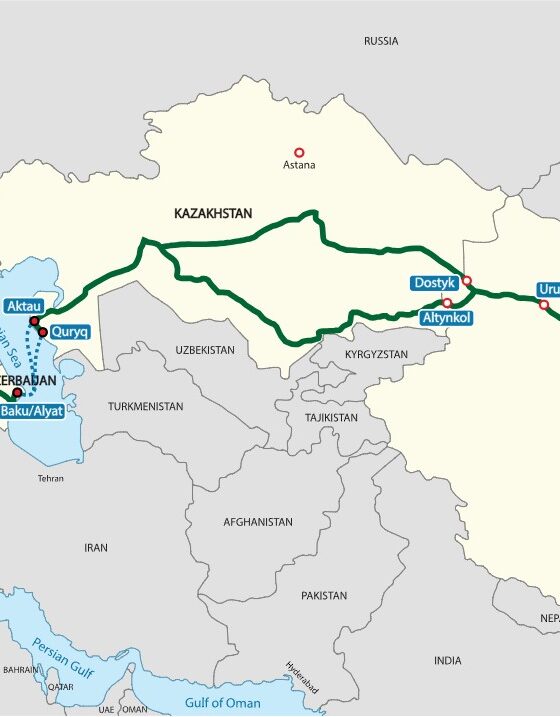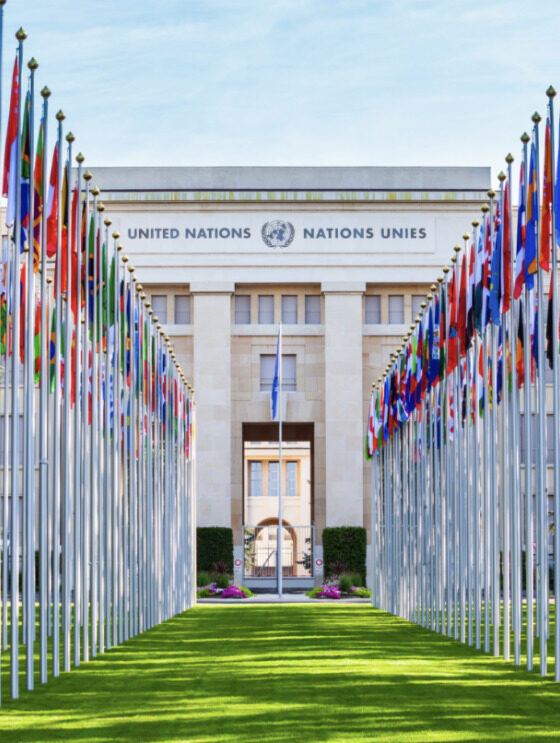By Rustam Muhamedov
 Muhamedov Rustam was a Spring 2021CAAFP Fellow. He is an independent researcher focusing on social-political and security developments in Turkmenistan and wider Central Asia. He is currently a non-resident research fellow at the Institut für Europäische Politik as part of the Eurasia Lab Fellowship Program, where he studies Turkmen digital activism and its democratization potential. He is alsoc ompleting his extensive study on open data practices in Turkmenistan within the framework of the Global Data Barometer2021 initiative. Rustam has also published several analytical articles on Turkmenistan in The Diplomat and CABAR.asia. Rustam holds a Master’s degree in International Relations from the OSCE Academy in Bishkek (2019).
Muhamedov Rustam was a Spring 2021CAAFP Fellow. He is an independent researcher focusing on social-political and security developments in Turkmenistan and wider Central Asia. He is currently a non-resident research fellow at the Institut für Europäische Politik as part of the Eurasia Lab Fellowship Program, where he studies Turkmen digital activism and its democratization potential. He is alsoc ompleting his extensive study on open data practices in Turkmenistan within the framework of the Global Data Barometer2021 initiative. Rustam has also published several analytical articles on Turkmenistan in The Diplomat and CABAR.asia. Rustam holds a Master’s degree in International Relations from the OSCE Academy in Bishkek (2019).
As they mark the 30th anniversary of their independence, the Central Asian republics are undergoing dramatic economic, political, and social transformations. One noteworthy development is an upsurge in grassroots social activism, particularly youth-led activism, against the backdrop of authoritarianism, which maintains its grip on much of the region. Young people, despite their demographic significance, find themselves largely excluded from decision-making and institutionalized politics. Furthermore, they face an array of socio-economic challenges resulting from inadequate policies and economic stagnation or crises. This has led to disenchantment with the leaderships of their respective countries, which have failed to improve young people’s quality of life and provide social justice, transparency, and accountability. Lacking access to formal political processes, young people are finding alternative, non-institutionalized channels through which to mobilize around causes and convey their concerns. The multifaceted character of these dynamics and their potential for generating progressive political and societal change are understandably drawing the attention of scholars, leading to the expansion of the literature on the topic.[1]
This study seeks to contribute to this strand of scholarship by focusing on Turkmen youth’s potential to address the country’s gender equality issues through civic engagement. Young people (aged 10-29) account for roughly 40% of Turkmenistan’s population,[2] making them a powerful force that will determine the trajectory of the country’s future development. Youth’s progressive views on gender equality and their active promotion of these views may help lead to a more democratic and equitable society, accelerate the country’s sustainable and inclusive development, and improve societal well-being, which is in high demand in Turkmenistan. It is hence crucial to unpack how this social group relates to gender equality issues, specifically entrenched gender biases and social norms.
The study seeks to answer the following question: To what extent are educated-abroad youth interested in and capable of contributing positively to the advancement of gender equality in Turkmenistan? This social group was selected because it presents a compelling case. Compared to their domestically educated peers, they have greater opportunity to receive a quality higher education and to socialize in an open and pluralistic political and social environment. Domestic youth must contend with a limited enabling environment for the development of independent thinking and democratic engagement: the government’s firm grip on all aspects of life and its measures aimed at cultivating a tractable, conformist, and politically indifferent society have resulted in youth becoming “disinterested and disengaged in social issues, uneducated and narrow-minded,” and preoccupied with personal well-being.[3] Educated-abroad youth therefore have greater potential to develop an interest in social issues and in activism.
To answer the research question, I conducted an online survey exploring young people’s attitudes toward gender-related issues, their conversance with existing gender disparities, and their interest in becoming engaged in addressing these issues. The study focused on young people pursuing higher education in Belarus and Russia, for the following reasons. Given the socio-political environment of the two host countries, these young people are less expected to be attracted to so-called “Western values.” With regard to gender equality specifically, it is expected that this group would at best become receptive to rather “moderate” views, considering systemic problems, norm contestation, and ambivalent narratives related to gender issues in these states. Given that the overwhelming majority of Turkmen students obtain their degrees from these two countries, then return home and pursue careers predominantly in state-provided public services (e.g., education), focusing on this group can offer insight into the trajectory of gender equality in the country. The study also draws on official documents, the reports of governmental bodies and international organizations, media materials, and academic sources to provide contextual background.
The study concludes that while there is increasing interest among young people in assuming more active civic roles in their communities, their potential positive contribution is impaired by their limited relevant experience, knowledge of the issue, and existing barriers. Young people are wary of the state’s rather repressive posture toward independent citizen activism and express uncertainty as to which form of action could bring about tangible results. As such, while small-scale positive changes can be expected at community level, positive breakthroughs at national level remain highly unlikely.
In conducting this research, I encountered limitations occasioned by the limited available data. The data on Turkmenistan are scarce and patchy, and data provided by the government are often distorted and taken out of context, which complicates any effort to make a detailed and accurate assessment of the situation on the ground. According to UN Women, only “20.6% of indicators needed to monitor the Sustainable Development Goals from a gender perspective” are available for Turkmenistan. Significantly, there are gaps in such key areas as violence against women, physical and sexual harassment, and access to assets.[4] For this reason, Turkmenistan is absent from the Gender Inequality Index, the Global Gender Gap Index, and the Gender Social Norms Index. The study would also have benefited from having a larger sample size to ensure representativeness. Nevertheless, the study still provides valuable insights into the subject matter that may provide a foundation for further research.
This work is structured as follows. The first section provides a succinct overview of the existing gender disparities in various social spheres in Turkmenistan and the role of gendered social norms in shaping power dynamics between women and men in society. The second section discusses the conceptual basis of civic engagement, its positive impact, and the role of the enabling environment, with a particular focus on the Turkmen government’s failure to address systemic problems that prevent local youth from developing a predisposition toward active citizenship. The third section discusses the very few initiatives that aim to equip domestic youth with the knowledge and skills to play active civic roles in their communities, with a particular focus on gender issues. The final section highlights the main findings of the survey, before a conclusion and recommendations are provided.
The Many Facets of Gender Inequality in Turkmenistan
Legal Reforms and Gaps
The Turkmen government has taken important steps to improve its legal framework on gender equality and bring it into line with international norms. The government has adopted new laws such as the State Guarantees for Ensuring Equal Rights and Equal Opportunities for Men and Women Act (2015), the Employment Act (2016), and the Civil Service Act (2016), among others; included a provision in the Constitution prohibiting discrimination on the basis of sex;[5] and developed state strategies and action plans that target gender inequality. The main purpose of these energetic efforts is to demonstrate the government’s commitment to the advancement of gender equality to an international audience. It is indicative that while Turkmen officials often refer to these legal reforms when describing the progress made, they provide little to no information about how these laws are implemented on the ground.
The evidence suggests that these “reforms” are largely “paper waste.” They fail to adequately protect women from the discriminatory restrictions that they often encounter, such as bans on purchasing cigarettes, driving cars or renewing driver’s licenses, dying hair, wearing nail varnish or nail extensions, etc.[6] In most cases, the authorities are themselves the source of such discrimination and may even engage in demeaning acts such as mandatory gynecological examination of schoolgirls to determine virginity.[7] The latter case vividly demonstrates how the formal progressive reforms run up against deeply entrenched patriarchal views, including at the official level, about control over a woman’s body.
The problem is aggravated by the absence of a genuinely independent institution dedicated to the protection of women’s and girls’ rights. In this regard, the country’s ombudsperson has been particularly criticized by international organizations and human rights watchdogs. The ombudswoman’s first ever report on the human rights situation in the country was found to be plagiarized,[8] highlighting official incompetence and neglect. In addition to the fact that only a small number of the complaints submitted each year are resolved (25 out of 254 in 2018[9]; 16 out of 985 in 2019, including 3 complaints of civil and political rights violations out of 150 received[10]), the reports have been found to focus on uncontroversial issues while neglecting more serious abuses such as those discussed above.[11]
It is also of particular concern that Turkmenistan has still not developed comprehensive legislation criminalizing all forms of gender-based violence against women, despite the urging of the Committee on the Elimination of Discrimination against Women. State officials argue that there is little practical need for such legislation, as the country’s Criminal Code already contains provisions criminalizing domestic and sexual violence. Officials also add that such instances are rare, appealing to the small number of registered cases of domestic violence (exact numbers are not provided).[12]
In reality, violence against women—in its various forms—is widespread. Efforts to combat these practices are thwarted by the absence of a legislative framework; the lack of or compromised access to legal remedies and support services; and the prevalence of traditional gendered social norms. Victim-blaming and self-blaming are common responses to the violence because the widely accepted traditional thinking views women as submissive wives. Hence, instances of violence are perceived as resulting from their own “improper behavior.” The same thinking leads to disapproval of disclosing such cases to the public, as they are seen as private matters to be dealt with by households.[13] Consequently, women generally fail to get support and an adequate response from their own or their husbands’ families—and, most importantly, from law enforcement bodies.
As a result, women are compelled to endure the abusive environment. This leads to the normalization of violence and the reinforcement of traditionally imposed gender roles. This point is exemplified by data from the 2019 Multiple Indicator Cluster Survey (MICS), which show that 58.4% of surveyed women believe that a husband is justified in beating his wife if she fails to comply with certain expected gender roles (see Table 1).
Table 1. Turkmenistani women’s attitudes toward domestic violence
| The circumstances/expected gender roles | The percentage of women who believe a husband is justified in beating his wife |
| If she goes out without telling him | 19.2 |
| If she neglects the children | 38.6 |
| If she argues with him | 26.0 |
| If she refuses to have sex with him | 4.6 |
| If she burns the food | 3.3 |
| For any of these five reasons | 48.6 |
| If she does not respect her husband’s parents | 43.1 |
| For any of these six reasons | 58.4 |
Source: The State Committee of Turkmenistan for Statistics and UNICEF, “2019 Turkmenistan Multiple Indicator Cluster Survey. Survey Findings Report” (Ashgabat, Turkmenistan: State Committee for Statistics of Turkmenistan and UNICEF, 2020), 179, https://mics-surveys-prod.s3.amazonaws.com/MICS6/Europe%20and%20Central%20Asia/Turkmenistan/2019/Survey%20findings/Turkmenistan%202019%20MICS%20SFR_English.pdf.
Political Empowerment
Progress on women’s political empowerment has also been largely superficial. Women are still significantly underrepresented at all levels of decision-making and only sporadically receive access to higher-level institutional roles.
Turkmenistan has recorded a modest increase in women’s participation in the national parliament over the past two decades, from 18% (1995) to 24.8% (2019).[14] The share of women in lower-level representative bodies is even smaller, with the exception of district and city councils (26%). Women hold only 20.42% of total seats in regional councils and 22.05% of total seats in rural councils.[15] The numbers may seem satisfactory, reflecting the global average; however, numbers alone do not tell the whole story.
The country’s political system and gendered social norms, which do not see women as autonomous decision-makers, impair the propulsion of women to the front lines of politics. Women are most often selected for visible political posts in order to imitate adherence to international practice; they do not enjoy autonomy in their decision-making, as all posts and institutions in the country are deprived of such powers, except for the presidency. Notable high-ranking female officials include the country’s ombudsperson (Yazdursun Gurbannazarova), the chair of the national parliament’s lower chamber (Gülşat Mämmedowa), and the permanent representative of Turkmenistan to the UN (Aksoltan Ataeva).
Inequality in Education
The gender gap in education is relatively less pronounced than that in other areas. This is due primarily to the existence of free, largely accessible, and compulsory primary and secondary education, where gender parity is close to being achieved. As a result, the overall level of education and literacy rate remain equally high for both women and men. Nevertheless, women face noticeable constraints on their educational aspirations. The figure for expected years of schooling for women stands at 10.9 years, compared to 11.5 years for men.[16]
Women’s low enrollment in post-secondary education (see Figure 1) is the result of systemic problems in the education sector that reinforce social exclusion and prevailing cultural prejudices that expect young women to follow traditional gender roles when it comes to their careers and families. The 2019 MICS data show that only 6.7% of young women are still in some form of training at the age of 19, compared to 21.6% of young men of the same age.[17] Most young women attend secondary vocational schools, which neither significantly improves their opportunities on the job market nor helps them to continue their studies. The vast majority of these schools offer training in low-paid careers: nursing, weaving, caretaking, etc. The quality of education in these establishments is poor and focused on developing narrow professional profiles.[18]
At the tertiary level, the share of women drops significantly, to 38.5%.[19] This pattern has long remained largely constant; the proportion of women has increased by only 3% since 2015.[20] Disparities also persist in terms of students’ areas of study: men dominate high-demand areas such as industry, agriculture, transport, and communication, while women’s representation in STEM (Science, Technology, Engineering, and Mathematics) subjects is particularly low (no exact data available). Though the government acknowledges these limitations, it has yet to adequately address the underlying problems in education that reinforce these disparities. The systemic problems in education will be discussed in detail in the next section.
Figure 1. Enrollment ratios at different educational levels (by gender, %)
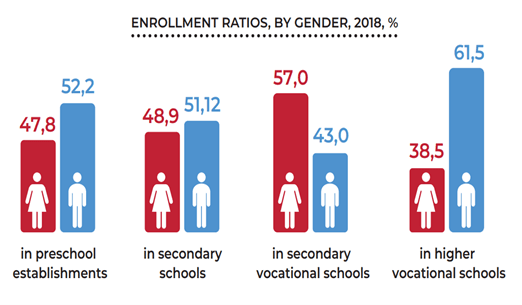
Source: Government of Turkmenistan, “Voluntary National Review of Turkmenistan,” Sustainable Development Goals Implementation, Turkmen State Publishing Service, July 2019, accessed June 20, 2021, p. 28, https://www.unicef.org/turkmenistan/media/866/file/Voluntary%20National%20Review%20of%20Turkmenistan%20.pdf.
Women in the Economy
Taken together, substandard legal enforcement and protection mechanisms, constrained educational opportunities, and persistent gender stereotypes translate into unequal treatment of women in the labor market. Women experience discrimination in access to jobs and in workplaces, occupational segregation, unequal payment, the additional burden of unpaid household and caretaking responsibilities, and constrained access to factors of production (such as land and capital). The worsening economic crisis and the COVID-19 pandemic serve as additional aggravating factors, hitting women the hardest.
The patchy available data show that women’s labor force participation is lower than that of men: in 2016, women’s participation stood at 53.8%, compared to men’s 78.2%;[21] in 2019, women’s participation dropped to 39.4% according to ILO estimates[22] and 51.4% according to UNDP.[23]
Despite the legal removal of restrictions on the types of economic activities that women can pursue,[24] occupational segregation persists. Women are predominantly employed in “traditional” female occupations, including light industry and food production, agriculture, fishing, hospitality and restaurant service, healthcare and social work, education, and art. The shares of women in vulnerable employment and in the informal sector are also sizable, at 20% and 57%, respectively.[25] Given the peculiarities of such jobs, women face additional risks in securing their social protection and employment benefits. Related to this are overwhelming unpaid household and caretaking responsibilities; according to state data, 91.4% of people engaged in the household are women.[26] This burden leads to time poverty, reduced economic mobility, and diminished opportunities for skills enhancement, further constraining women’s professional advancement.
Underrepresentation in the sectors with the highest compensation and in senior positions results in lower incomes for women. In less-demanding, lower-paid jobs, which have traditionally been occupied by women, the pay gap is not particularly pronounced, at only 2-10%. In more demanding, higher-paid jobs, which are dominated by men, the income gap widens, reaching 28% in extraction industries, 24% in transport, and 13% in construction.[27] These disparities diminish women’s financial autonomy, which in turn reinforces their subordinate social and decision-making roles.
Barriers to Youth Civic Engagement in Turkmenistan
Conceptualizing Civic Engagement: Its Positive Impact and the Role of the Enabling Environment
It is difficult to define the term “civic engagement” due to its “conceptual stretching,” as discussed by Marinin in his work on civic engagement in Kazakhstan.[28] As Adler and Goggin underline, the varied definitions of civic engagement focus on different dimensions and aspects, depending on the emphasis of the definer.[29] Civic engagement is widely conceptualized as activity that identifies and addresses issues of public concern with the aim of generating progressive positive change in a given community.[30] A broad spectrum of both institutionalized and non-institutionalized activities is considered to constitute civic engagement: individual volunteerism, electoral participation, organizational involvement, etc.
Political participation is recognized as particularly instrumental for bringing about change, since informal means such as protests cannot fully replace institutionalized politics, even in authoritarian states.[31] In her study of social activism in Kazakhstan, Insebayeva presents groups of activists who share this sentiment, highlighting the need to work with the government and “look for opportunities under the current order and make gradual changes to political and social structures.”[32]
Nevertheless, given the limited number of sanctioned ways to influence decision-making through institutionalized channels in Central Asian countries, especially in Turkmenistan, this study finds it more suitable to focus on other forms of engagement. These may include volunteerism, donations, participation in education initiatives and awareness-raising campaigns, and other community-oriented actions, including those conducted via digital means. This work therefore follows the studies of Kosnazarov and Marinin, which explore less politically direct forms of civic activism in Kazakhstan.[33] Such an approach makes it possible to capture “the hidden tendencies of civic participation in authoritarian states”that may not constitute direct political participation but may still bring about positive change and build the potential for political action.[34] The political and social participation of Turkmen youth is significantly understudied, with the notable exception of Halimova’s work, which explored the shortcomings of Turkmenistan’s policy approach to creating favorable conditions for young people’s economic participation, which impedes the country’s development.[35] This study, although having a different focus, also seeks to fill in gaps in the literature.
There has been increased recognition of the value of young people’s civic engagement as it pertains to their individual development as well as that of their community and society as a whole. The World Bank notes, for instance, that youth civic engagement is “one of the most important activities for a healthy transition to adulthood.”[36] Exposure to civic issues and civic education at an early age “is foundational to creating future engaged civic actors” and contributes to the “sociopolitical empowerment” of young people by boosting their self-esteem and well-being.[37] The extensive literature highlights a wide range of positive outcomes resulting from youth’s active community engagement, such as meaningful positive relationships with the community, better problem-solving and decision-making skills and development of leadership potential, and decreased traditional problem behavior, among others.[38] Recognizing this, the United Nations launched a global multi-stakeholder partnership, “Generation Limited,” that aims to enhance youth empowerment through the expansion of education, training, and employment opportunities for young people.
For youth civic engagement to flourish, there is a need for a supportive environment that would empower young people with the requisite healthy civic habits, knowledge, and set of skills and attributes. The socio-political and learning environments in which young people develop and interact have a significant impact on how they navigate their transition to adulthood, including perceptions about their intrinsic value for the community. The research indicates, for instance, that “social, collaborative, and interactive methods” are the most effective in building positive dispositions toward civic engagement. The studies show the particular benefit of actively engaging young people in real-world decision-making environments and activities that simulate such environments.[39] The education system can play an important role in this by providing a venue for young people to develop and practice engagement through in-class discussions as well as participation in class councils, youth clubs, and/or initiatives led by young people.[40] It is hence imperative that the formal education system foster participatory forms of learning and equip young people with foundational and transferable skills. It is equally important for the community at large to develop and support activities and platforms that would allow young people to voice their concerns and influence decision-making while learning the value of volunteerism and community service.
Turkmenistan’s Youth Policy
There is a considerable gap between the state’s official rhetoric and the reality on the ground in terms of creating favorable conditions for young people to develop as active citizens. On paper, the government adopts progressive laws that seek to highlight its recognition of the youth’s strategic importance for the country’s future. The government adopted the Law on State Youth Policy (2013) and the 2015-2020 Programme of the State Youth Policy of Turkmenistan,[41] and established an Interagency Commission on Employment of Young Professionals in 2017 to improve career guidance for young people and increase their economic involvement.[42] The government has also implemented educational reforms, prolonging secondary schooling to twelve years, incorporating new disciplines into school curricula and adding new areas of studies in universities, initiating the digitalization of the education system, and establishing new universities.[43] These reforms, however, are mostly perfunctory in character and do not address the underlying systemic problems that continue to constrain young people in their educational aspirations, professional opportunities, and societal actions.
The country’s education system continues to suffer from a multitude of structural deficiencies. The capacity of Turkmen universities remains among the lowest in the world, with demand significantly exceeding supply (see Figure 2). In 2020, for instance, state universities and secondary vocational schools were to admit 14,337 and 9,490 young people, respectively,[44] while the number of graduates that year was over 80,000 students.[45]This low intake breeds corruption and abuse of office, circumscribing access to education for most people, who are unwilling or simply unable to pay bribes that can reach tens of thousands of dollars. These policies particularly affect residents of rural and remote areas, young women, ethnic minorities, and people with disabilities, widening the inequality gap and social exclusion.
Figure 2. Number of students in higher and secondary vocational training schools in Turkmenistan (in thousands)
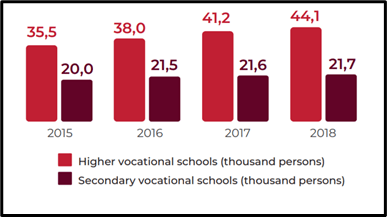
Source: Government of Turkmenistan, “Voluntary National Review of Turkmenistan,” Sustainable Development Goals Implementation, Turkmen State Publishing Service, July 2019, p. 27, https://www.unicef.org/turkmenistan/media/866/file/Voluntary%20National%20Review%20of%20Turkmenistan%20.pdf.
The significant underfunding of the country’s public education, science, and research due to state-sanctioned mismanagement is another major concern. According to UNICEF estimates, state funding for public education stood at 3.3% of total government expenditure in 2016.[46] In recent years, due to the ongoing economic crisis, investment in education and research and development is estimated to have dwindled to around US$150 million and US$15 million, respectively (2018).[47] Furthermore, the government plans for higher education institutions to transition to self-financing and collecting fees by 2024, which suggests that there will be further cuts in public spending in the years to come.[48] At the same time, the government continues to overspend on showcase construction projects; in recent years, around US$37 billion has been invested in 2,500 projects,[49] which have inflated costs but minimal societal or economic benefit.
Heavy-handed state management and the lack of adequate funding have had detrimental effects on the quality of public education at all levels. Institutions struggle with a lack of qualified instructors and outdated teaching materials and means. The continuous mobilization of both teachers and students as “extras” in state-sponsored mass events reduces instruction time. In addition, the classroom climate in Turkmen educational institutions does not promote academic freedom and critical engagement with the material, instead overloading students with politicized and ideologized teaching. The teaching of the previous president’s pseudo-religious book, Rukhnama, was finally eliminated in 2013, only to be replaced with the teaching of the countless literary works of the current president.
Young people do not enjoy meaningful political and societal participation and their interests are not adequately fed into the political system. The country’s main public association representing youth, the Youth Organization named after Magtymguly, is state-led and state-sponsored, and hence lacks institutional autonomy to advocate for sweeping reforms. Though the Organization did contribute to the law on State Youth Policy and to the 2015-2020 State Youth Policy Program, as well as to the establishment of the Young Scientists Council,[50] it still plays a rather limited and largely decorative role in making decisions that affect young people.
The structural problems in the education sphere, inadequate responsiveness to youth’s needs and concerns, and reluctance to view youth as equal partners, as well as the generally repressive political and social environments, have a negative impact on young people’s development as active and responsible civic agents. UNICEF-held consultations indicated that while adolescents aged 12-16 were aware of their right to express themselves freely, they lacked the necessary skills to exercise this right “confidently, irrespective of views held by others.”[51] Adolescents were also less aware that children’s rights should be given due consideration, were not familiar with the participatory process, and were not “regularly consulted in the home and school environments about all aspects of their lives.”[52] These responses highlight that Turkmen youth lack the proper environment to become informed about democratic processes and practices and about active citizenship. Given the classroom environment, young people face constraints in developing proper problem-solving, decision-making, leadership, and critical thinking skills. Moreover, in light of the wider repressive political and social environments, young people lack the platforms, initiatives, partnerships, and networks that would allow them to make their voices heard and push for meaningful change through civic engagement. As such, they risk developing weak links to their community and its concerns, focusing instead on self-centered narrow interests. Acknowledging the detrimental effects of such developments for positive societal growth, a number of international organizations and domestic independent initiatives have been taking action to fill in the skills and knowledge gap and to improve young people’s civic engagement capacity. The following section discusses these initiatives with a particular focus on gender issues.
Developing Civic Potential in Turkmen Youth: Non-State Initiatives
Young people are recognized as important facilitators of gender equality. At the same time, this group is particularly vulnerable to gender-based discrimination and gendered social norms. In Turkmenistan, traditional gender roles become entrenched as adolescents reach 12-14 years of age, intensifying further at 15-17 years of age.[53] At this age, young women start to assume most household responsibilities for their busy mothers. They learn that juggling competing priorities is the norm and develop the attitude that household caring responsibilities are more important than their personal professional or academic ambitions.[54] This, in turn, leads to a cascade of negative developments, such as high school dropout rates, poor academic performance, low enrollment in post-secondary education, early marriages, and limited employment opportunities, all of which reinforce existing disparities. In light of this, a range of actors have been taking steps to increase in young people’s awareness of gender issues and levels of participation and civic engagement.
The Union of Women of Turkmenistan
The Union of Women of Turkmenistan is a state-led and -funded public association that is “fully involved in all gender related activities.”[55] The Union conducts an impressive number of activities that try to reach almost all social groups, including youth. The organization hosts shows on gender equality on national television (16 in 2018), public speaking events with officials who serve on local councils (8 in 2017-2018), lectures for young women on reproductive health and early pregnancy (136 in 2017-2018), and exhibitions and roundtables on improving women’s entrepreneurship, to name but a few.
Despite these impressive numbers, the Union’s activities fall short of bringing about positive breakthroughs because the organization acts more as a conduit of the state’s agenda than as an agent for women. The materials on the organization’s website reflect the authorities’ success stories about the advancement of gender equality. Furthermore, the Union has never criticized state gender policy nor raised concerns about neglected issues or the state’s violations of women’s rights and freedoms. It is also indicative that the state directly intervenes in the Union’s activities, with the President setting the priorities of its work; in December 2020, for instance, he “ordered [the organization] to expand support for women who are engaged in scientific activities.”[56]
Independent Initiatives Jora and Saglyk
The civil society space does include a few local independent actors and initiatives worthy of discussion, such as the online-based Jora (“girl friend” in Turkmen) and Saglyk (“health” in Turkmen). Jora was launched in November 2019 on Instagram and Imo messenger. This initiative focuses on young women, seeking to improve their awareness of issues relating to physical, emotional, and psychological health. Jora covers topics like the stigmatization of women, bullying, virginity, toxic relationships, the benefits of visits to gynecologists, study strategies, etc. (see Figure 3).
Jora plays an important positive role, as it provides publicly accessible, reliable, and accurate information in Turkmen language on topics that are not widely discussed among the Turkmen public, being viewed as “taboo.” To make matters worse, these topics are also often neglected in families. According to the Health Behavior in School-Aged Children survey (2016), only 2% of adolescents (ages 15-19) reported that family is their main source of information on reproductive health.[57] This results in a dearth of knowledge, which in turn makes adolescents more susceptible to inaccurate information about their own health: to give just one example, the most frequently asked questions among Jora’s followers, according to activists, involve myths about virginity and the hymen.[58]
Saglyk shares Jora’s goals but targets a much wider audience and has a greater thematic scope. The initiative was launched in 2009 as a web portal to provide reliable and unbiased information from health professionals in an easy-to-digest format in Turkmen language. Its mission is to improve the Turkmen public’s (and particularly youth’s) overall health literacy.
Coverage of gender-related issues and sexual education is one of the initiative’s priorities, since 85% of all questions received from readers are related to reproductive health, according to the founder of Saglyk, Aynabat Yaylymova.[59] As such, Saglyk contributes to confronting gender prejudices by advancing gender-sensitive content that seeks to normalize public discussions on issues related to sexuality and family planning, including safe sex, contraception, the health of mother and children, and the role of fathers in families (see Figure 4). Saglyk, for instance, makes considerable efforts to promote respectful and correct language regarding sexuality education. Through its activities, Saglyk tries to mitigate the negative impact of pornography and distorted religious teachings, which promote despotic attitudes in gender relations, as sources of sexuality education for young people.[60]
Figure 1. Posts from Jora’s Instagram
The posts’ captions (from top left) read: “Painful Menstruation” in Turkmen and Russian; “The Cycle of Violence—What Is It?” in Russian and Turkmen; “5 TV Series about Powerful Women” in Russian and Turkmen; “If You Have Had a [Sexual] Experience” in Russian and Turkmen; and “He Already Forgot—What About You?” in Russian.

Source: https://www.instagram.com/joralar/?hl=en.
Keyik Okara, another public association, has been involved in the issue of domestic violence for over 10 years, organizing trainings, distributing materials, and (together with the Ynam association) operating a domestic violence hotline for women. In October 2020, it launched a support line on reproductive rights, health, and COVID-19 for women and girls with support from the UK Embassy and UNFPA.[61] The association also maintains a shelter for victims of domestic violence, where they can get psychological support, legal aid, and assistance with employment. In one year, Keyik Okara received 1,070 distinct calls; 24 people were sent to the shelter, 473 were provided with psychological support, and 207 received legal counsel.[62] Recognizing the importance of youth, the organization helps foster youth empowerment by maintaining a Youth Center where young people can develop soft and leadership skills and commitment to civic engagement through training and peer-to-peer interaction.
Figure 4. Saglyk’s visual article on gender stereotypes about young women
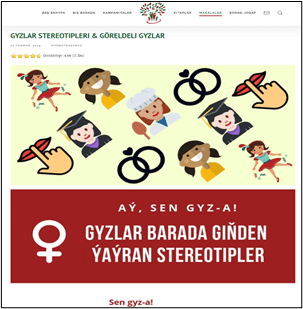
Source: https://saglyk.org/makalalar/sagdyn-durmus/yetginjekler-dunyasi/1495-gyzlar-stereotipleri-goreldeli-gyzlar.html.
The positive role of these initiatives cannot be overemphasized, as they work in areas in which the state has considerable gaps and shortcomings. Nevertheless, their impact is very limited due to their low human, financial, and technical capacities. Keyik Okara, for instance, operates only in Ashgabat and Akhal region. Saglyk and Jora operate online and hence have limited outreach due to the low Internet penetration rate in Turkmenistan and its low quality where it does exist, the low digital literacy of the population, and the government’s repressive actions in the online space. Their limited outreach is reflected in their small number of followers: Saglyk, for instance, has 1,000 followers on Facebook, 3,000 on Twitter, 13,500 on Instagram, and 3,600 on VK. Furthermore, these organizations struggle with a lack of recognition from the state, which does not view them as “equal partners” in its gender-focused activities and does not take steps to support and expand their work.
International Organizations
The spectrum of actors also includes a small number of international organizations and foreign embassies, namely UNFPA, UNDP, UNICEF, the OSCE Center in Ashgabat, and the United Kingdom and United States embassies. International actors encourage national ownership of domestic reforms, and hence mainly engage by providing technical, financial, and other support to domestic partners (both national institutions and independent initiatives) and by advocating further improvement of the national legislative framework and its effective implementation. Their engagement is limited by the Turkmen government’s strenuous efforts to keep its foreign partners at arm’s length. Despite limitations, these actors have proven themselves helpful in the advancement of gender equality and in youth empowerment.
UNFPA plays an important role in tackling gender biases through active engagement of youth. It maintains the Yashlyk (Youth) website, which provides youth-friendly and gender-responsive content to improve young people’s literacy on issues like sexuality education and reproductive health. The website has already been reached by 130,000 young people. UNFPA has also supported the preparation of teaching standards and aids on reproductive health for the Basics of Life Skills course in schools and universities.[63] In addition, it organizes social media campaigns, such as #ErkeklerHem (Men Engage), #Kakambilen (With My Dad), and #Arzylyzenan (She Counts), that seek to foster intergenerational dialogue on tackling traditional gender perceptions.
UNFPA also supports the Y-PEER initiative and youth centers, which promote peer-to-peer reproductive health education. Currently, however, only two youth centers are operational (in Mary and Ashgabat); these are fully funded by UNFPA, as the government has still not demonstrated a commitment to supporting them financially and expanding this network to other administrative centers. The centers help prevent bad habits and improve youth’s knowledge about sexually transmitted diseases, including HIV/AIDS, unintended pregnancy, and gender-based violence. The role of Y-PEER volunteers is particularly noteworthy: in 2016-2019, volunteers reached 17,452 young people (9,091 boys and 8,361 girls) by providing peer-led sessions not only in centers, but also in schools and summer recreational camps.[64]
UNICEF is engaged in supporting early childhood and youth development, working to reduce social inequities and improve the quality and inclusivity of learning. The organization promotes a multi-sectoral response to gender-based inequality. UNICEF is also engaged in addressing adolescent girls’ health by focusing on anemia prevention and challenging traditional gender roles by engaging fathers, reaching grandmother decision-makers, and supporting female health professionals.[65]
Another important actor is the United States, which supports various activities through the Embassy, USAID, and American Councils for International Education. The Embassy sponsors various academic and professional exchange programs to the US that target school and university students, as well as early- and mid- career professionals. One such program is TechWomen, which empowers women to advance their careers in STEM and become role models for women and girls in their communities. Since 2015, 12 women from Turkmenistan have benefitted from this program. Upon completion of the program, they have carried out a variety of activities to encourage young women to pursue careers in STEM, such as holding seminars on mentorship, piloting STEM programs for girls, and launching a Google Developer Group in Turkmenistan.
USAID strengthens the capacity of the country’s youth to meet the demands of the labor market through its Enriching Youth for Tomorrow initiative. To date, the Agency’s skills development training and internship programs have benefitted 2,558 young people, 61% of whom gained employment and 71% of whom increased their incomes after completing the program. Of 526 post-graduate youth trained in entrepreneurial skills, 12% have started their own business and 30% have continued to participate in startup programs. In addition, USAID has provided methodological and training support to teachers in the fields of economics and entrepreneurship, including the development of 15 learning manuals. Finally, USAID has developed soft skills training programs tailored to Turkmen youth, including the “I Can” program targeting youth with disabilities.[66]
The aforementioned initiatives contribute significantly to the empowerment of local youth, particularly young women, by helping them gain soft skills, sharpen their knowledge, and understand and practice their rights. They also foster young people’s civic responsibility by engaging young people as important “partners” in implementing projects and encouraging knowledge-sharing and its application for the community’s good, including in the area of gender equality. However, these initiatives have limited impact, as they reach only a small fraction of the country’s youth. Hence, the situation remains unchanged for the majority of young people, particularly the most disadvantaged (i.e., those residing in rural areas and not in education, employment, or training), who continue to feel isolated from public issues and unequipped to drive positive change in their communities. Do educated-abroad youth fare better in this regard, given the different socio-political and learning environment in which they have been socialized?
The Potential for Civic Engagement of Educated-Abroad Turkmen Youth
Turkmen Students Abroad: The Cases of Russia and Belarus
Foreign higher education is in great demand in Turkmenistan, where it is widely perceived as the most prestigious form of education. Due to the low admission rates and poor quality of local universities, many school graduates seek university admission abroad. The Turkmen government does not publish statistics on how many Turkmens study abroad, but estimates put this figure at 95,000 young people.[67] The post-Soviet countries, primarily Russia and Belarus, remain the main destinations for Turkmen students due to “pull” factors: the relatively high standard of education and its affordability, affordable living costs, less demanding curricula than Western universities, students’ preexisting knowledge of the Russian language, and the large number of compatriots already studying there.
As a result, in the 2019-2020 academic year, 36,389 Turkmen students were pursuing their higher education in Russia, making them the third-largest group of foreign students.[68] In that same period, 9,788 Turkmen students were pursuing their higher education in Belarus, constituting 53.1% of all foreign students in the country.[69]The most popular areas of studies are estimated to be: teaching (41%), health care (31%), foreign languages (15%), economy (9%), and law (7%).[70]
In recent years, for economic and political reasons, the Turkmen government has been taking steps to minimize the number of students studying abroad. The government has been tightening limits on money transfers from parents and cash withdrawals for students, which make it difficult for the latter to pay university fees and maintain a decent standard of living. These measures are intended to limit cash outflows amid the worsening economic crisis. In addition, the government has made a list of foreign universities and areas of study that will be recognized by state bodies,[71]as well as imposing arbitrary bans on leaving the country. Such restrictions are intended to curtail exposure to freer and more pluralistic socio-political environments in a context of growing discontent with the government.
Turkmenistan has always been wary of educated-abroad students, even those pursuing degrees in countries like Belarus and Russia. These students benefit from freer access to information critical of the government, enabling them to gain a better understanding of the socio-political troubles at home and the government’s mismanagement. Suspicion of educated-abroad students has grown following a wave of anti-government protests and pickets staged by Turkmens living abroad throughout 2020. There has also been an increase in Turkmen online activism, including among students studying in Russia and Belarus. Rozgeldy Choliev and Malik Allamyradov, both studying in Russia, have been engaged in social media activism, posting videos criticizing the government; Allamyradov has been running a YouTube channel, “For Turkmenistan’s Honor,” that he uses to criticize the authorities’ restrictive money transfer policies. Some Turkmen students were even detained by the Belarusian authorities for taking part in anti-Lukashenka protests in Belarus in August 2020.[72]
These and other examples indicate that some Turkmen students are interested in public issues in their home country and engage in some forms of civic activism. To prevent this engagement from developing further, the government has stepped up its efforts to intimidate such activists through the consulates, which urge local universities to take drastic measures. Choliev, for instance, was summoned to a discussion with an official from the university he was enrolled in, who accused him of “defaming the country” and threatened to return him to Turkmenistan. Similarly, Allamyradov was pressured by university officials to discontinue his civic activities under threat of expulsion.[73] Overall, however, Turkmen students try to avoid engagement in such activities, fearing persecution. This fear is stimulated further by Turkmen authorities’ firm grip on students in Belarus and Russia. Consulate officials hold regular meetings with students, have informants among them that pass information to the domestic security services, and closely engage with university and state authorities on all matters related to Turkmen students.
Educated-Abroad Students and Gender Equality Issues: Highlights of the Survey Findings
The preceding discussion has provided a glimpse of the complexity of young people’s relationship to socio-political issues in Turkmenistan and to civic engagement. Yet these students’ relationship to gender equality issues and interest in addressing them remains largely unclear. To gain a better understanding of this question, I conducted an online survey using snowball sampling: I contacted my network of acquaintances studying in Belarus and Russia and asked them to participate in the survey and disseminate it further among their peers. As duly noted by Halimova, the lack of a culture of participating in public opinion polls among Turkmens results in their general reluctance to share their own opinion, even anonymously, particularly on issues viewed as potentially “sensitive.”[74] For this study, trust in the researcher proved to be the determining factor in people’s willingness to participate in the survey. Though respondents’ anonymity was guaranteed, 32 people explicitly refused to fill out the survey when they found out that the research would be publicly available.
As a result, only 93 people participated in the survey, of whom 63 were females and 30 males. Lebap, Mary, Akhal, and Ashgabat are the main provinces of origin of respondents, in order of magnitude. 46% of respondents study in Belarus and 51% in Russia; in addition, two respondents study outside of the focus area. In terms of year of study, the main groups are third-year students (35%), followed by fourth-year students (32%) and fifth-year students (12.9%). Although the study would have benefitted from having a larger sample to ensure representativeness, it still provides good food for thought and can be used as a stepping-stone for further research on the matter.
67.7% of respondents link their future to Turkmenistan. At the same time, only 29% of respondents wish to be employed in public services and only 3.2% in the NGO sector; international organizations are the most desirable entities to be employed in (35.5%), while foreign private companies are the desired destination of 22.6% of respondents.
Regarding engagement, the survey data show a low level of engagement in extracurricular activities among respondents (see Figure 5). While 58.1% of respondents stated that they are engaged in some kind of activity, only 9.7% of them participate on a regular basis. The overwhelming majority (71%) participate in one such activity or fewer per month (see Figure 6). Preference is given to studies-related events, such as conferences, seminars, or training (22.6%), followed by sports (19.3%), and cultural events (12.9%); only 3.23% of respondents engage in volunteerism and charity work. Furthermore, only 35.5% of students indicated that there was a self-organized Turkmen student body at their university, and just 9.7% said that they were part of such a body.
Figure 5. Turkmen students’ participation in extracurricular activities
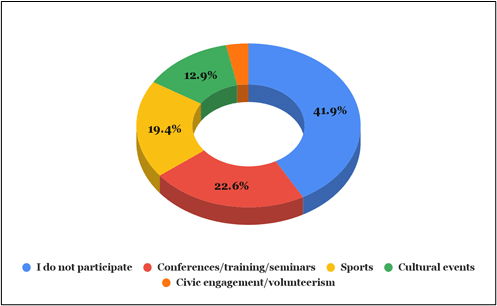
Source: Author’s survey.
Figure 6. Turkmen students’ frequency of participation in extracurricular activities
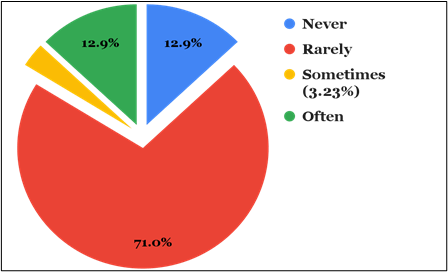
Source: Author’s survey.
These data show that while Turkmen students may be informed about various forms of engagement, they demonstrate little awareness about its value for their development. This is a particularly crucial point, given the evidence that many Turkmen students demonstrate laziness and absenteeism in their studies and engage in inappropriate behavior, such as fights, smoking cigarettes and hookah in their dorm rooms, and breaking university rules.[75] Private discussions with some respondents revealed that they prefer to participate in activities distant from politics, such as sports or cultural events, so as not to attract potentially unwanted attention from the Turkmen authorities. In particular, they highlighted participation in events that promote a positive image of Turkmenistan, demonstrating its cultural and historical richness. Students mentioned that they performed traditional dances in national costumes and cooked Turkmen food that was shared with their foreign peers and faculty during specially organized events, such as Nowruz and Independence Day celebrations. Participation in such events is welcomed by the Turkmen authorities: there is evidence that consulates try to mobilize young people to actively spread a positive image of the country by organizing dance and folklore groups to participate in local cultural events.[76]
Students also claimed to be relatively disinterested in local issues and to interact with their foreign peers mainly on class-related issues, which further explains their low rates of participation in civic activities. Although most students prefer to socialize with their compatriots, they try to avoid discussing socio-political issues in Turkmenistan outside of their circle of “trusted friends.” These insights indicate the weak social trust among students and the pervasiveness of the Turkmen government’s control.
In relation to gender issues, the survey results highlight young people’s limited capacity to drive positive change, which stems from a lack of knowledge about the topic (see Figures 7 and 8). Only 22.6% of respondents see themselves as very knowledgeable about gender issues in the context of Turkmenistan; the majority (around 61%) have a rather vague understanding, while 16.1% of respondents have no knowledge at all. 29% of respondents consider gender inequality a serious issue for their country; 38.7% of respondents find it somewhat serious and 16.1% find it not serious at all. At the same time, 38.7% of respondents find these issues “very important” on the personal level, with 29% claiming that they are somewhat important.
Figure 7. Turkmen students’ perceptions of the importance of gender equality issues on the personal level
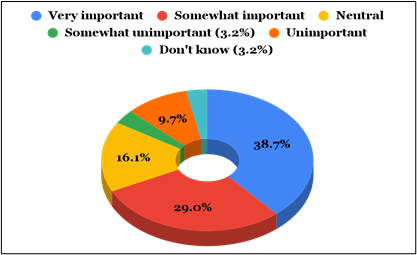
Source: Author’s survey.
Figure 8. Turkmen students’ level of awareness of existing gender disparities and gender-based discrimination in Turkmenistan
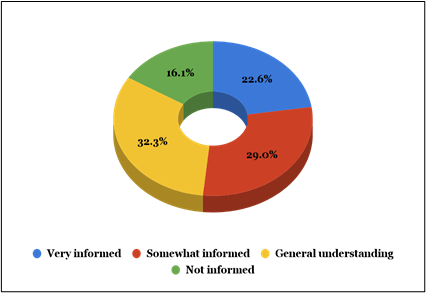
Source: Author’s survey.
University experience is not helping young people to improve their knowledge of the topic. 83.9% of respondents stated that their university does not conduct any activities or incorporate this topic into class curricula. This point is crucial, as there is a desire among respondents to improve their knowledge (71%) that remains unfulfilled. These findings also support the claims of many students that universities in Belarus and Russia are more interested in taking students’ money than in giving them knowledge. As Turkmen.news reports, many universities get Turkmen students to the minimum standard “so they at least move up to the next year of their course and continue to pay good money.”[77] For the same reason, students are encouraged to continue their studies with a master’s degree even when they demonstrate low academic results.
Regarding civic engagement, the findings paint a rather promising picture (see Figures 9, 10, and 11). Most students view the state’s role as secondary and supportive, while public associations (35%) and citizens/citizen-led initiatives (29%) are viewed as the most suitable actors for promoting the gender equality agenda. These numbers also correlate with the findings about limited awareness of the state’s initiatives, highlighting its shortcomings. 45.2% of respondents found it difficult to assess whether state efforts were sufficient to tackle gender inequality. Many students, in personal communications, said that they found it difficult to recall any meaningful state activities in this regard. 32.3% of respondents believe the state should do more, while 12.9% and 9.7% of students think that it does enough and more than enough, respectively.
When asked about their personal interest in getting involved, 54.8% of respondents answered positively, 32.3% negatively, and 12.9% that they were unsure. Regarding the form of activity in which they would like to engage, respondents prioritized social media (35.5%) and awareness-raising campaigns (22.6%); another 12.9% expressed interest in charity and donation. Significantly, only 16.1% of young people indicated an interest in participating in the activities of state-sponsored public associations.
Figure 9. Turkmen students’ perceptions of actors’ role in promoting the gender equality agenda in Turkmenistan
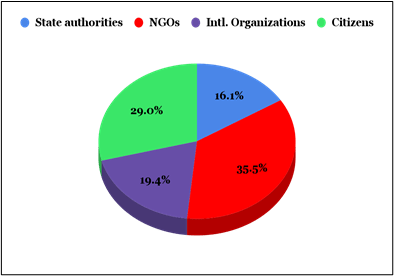
Source: Author’s survey.
Figure 10. Turkmen students’ attitude toward becoming personally engaged in civic activities advancing gender equality in Turkmenistan
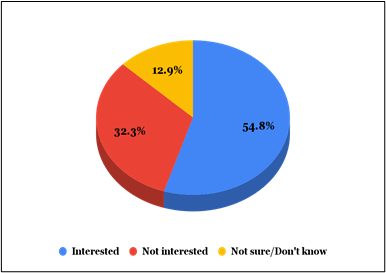
Source: Author’s survey.
Figure 11. Turkmen students’ preference for a form of civic engagement (number of respondents)
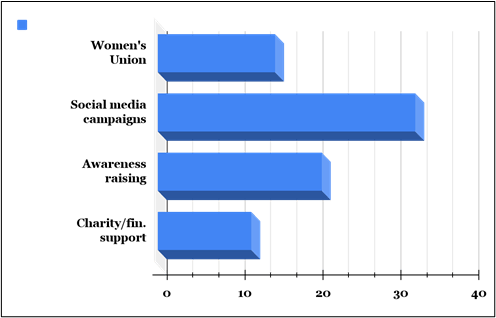
Source: Author’s survey.
Conclusion
The research findings paint an intricate picture. On the positive side, the majority of students are interested in taking action in their communities and view citizens and civil society as important facilitators of change, which indicates a growing sense of civic ownership. That being said, limited civic engagement capacity—which results from a lack of relevant experience and knowledge—represents a significant barrier to meaningful participation. Limited engagement prevents students from acquiring and enhancing civic habits, attributes, and skills, as well as from learning practices that work. Most importantly, it prevents them from seeing the tangible benefits that active citizenship can bring, even if these changes are incremental.
The majority of respondents, in personal communication, identified the state as the main barrier to their engagement. The contemporary socio-political environment in Turkmenistan is viewed as unwelcoming of independent civic participation, even on non-political issues; news of the state’s repressive actions toward citizens that speak out against the government, criticize its policies, or simply spotlight the local authorities’ mismanagement only fuels this wariness. As some respondents underline, in a context where the government is “tightening the screws” in response to growing popular dissatisfaction with its failure to address protracted socio-economic troubles, it is unclear what activities the authorities might find undesirable and worthy of punishment. This may explain why so many students chose social media and awareness-raising campaigns as their preferred form of civic action; participation in campaigns that spread positive narratives online, such as empowering messages about women, contribute positively to the cause while being less likely to antagonize the authorities and cause trouble. The other issue in this regard is weak social trust. Some respondents feel that their aspiration to engage would not be supported by their fellow citizens and hence would not significantly alter the situation for the better.
Considering these limitations, while it might be possible to observe minor positive changes at community level, it would be naive to expect considerable positive breakthroughs in society at large in the foreseeable future. While youth, particularly those educated abroad, can become solid facilitators of change, the research confirms that a proper enabling environment is required for that to happen. In the case of Turkmenistan, this means that the government needs to institute far-reaching reforms, particularly in the education sector, which is the principal societal institution where young people learn how to interact with society. The government needs to reshape the learning process, increasing student participation and support youth-led initiatives and platforms (especially at the secondary school level) that would teach youth the value of civic engagement. It would be particularly beneficial to support peer-to-peer learning models, which can contribute to strengthening social trust.
The government also needs to open up space for non-state actors so that they can complement its activities, especially in areas in which the state lacks capacity. The government could, for instance, support initiatives like Jora and Saglyk, assisting them in expanding their outreach. Finally, the state needs to meet its active citizens at least halfway, coming to view them as equal and important partners rather than as a threat to the state. As the research shows, this has the potential to increase civic participation, especially among young people, which would bring about positive changes in society. Given current political realities, however, this appears highly improbable. Thus far, the Turkmen government has not demonstrated a genuine commitment to implementing meaningful democratizing reforms and it is very unlikely that it will change its posture in the years to come. On the contrary, the evidence of the past several years suggests that the government has been boosting its repressive capabilities, including in the online domain, with the goal of practically eliminating the space for independent thinking and action. Given Turkmens’ growing “thirst” for change, the pressure under which the government operates is also increasing; in these turbulent times, it is hoped that the outcome of this interplay will not be disheartening for the future of Turkmenistan.
[1] See, for example, The Nazarbayev Generation: Youth in Kazakhstan, ed. Marlene Laruelle (Lanham, MD: Lexington Books, 2019); Daniyar Kosnazarov, “#Hashtag Activism: Youth, Social Media and Politics in Kazakhstan,” CAP Paper #217, The George Washington University, Washington, DC, 2019; Sergey Marinin, “Agents of Change? Civic Engagement of Western-Educated Youth in Kazakhstan,” CAP Paper #222, The George Washington University, Washington, DC, 2019; Nafissa Insebayeva, “Choosing Your Battles: Different Languages of Kazakhstani Youth Activism,” CAP Paper #226, The George Washington University, Washington, DC, 2020.
[2] UNICEF, UNFPA, and UNDP in Turkmenistan, “Situational Analysis on Youth in Turkmenistan,” Ashgabat, 2019, p. 1, https://www.unicef.org/turkmenistan/sites/unicef.org.turkmenistan/files/2019-12/YSitAn%20Report%20TM%20October%202019%20ENG.pdf.
[3] Dursunjemal Halimova, “Economic Smart Power: Utilizing the Untapped Asset of Turkmen Youth,” CAP Paper #172, The George Washington University, Washington, DC, 2016.
[4] “Country Fact Sheet: Turkmenistan,” UN Women, accessed June 20, 2021, https://data.unwomen.org/country/turkmenistan.
[5] “Concluding Observations on the Fifth Periodic Report of Turkmenistan,” Committee on the Elimination of Discrimination Against Women, United Nations, CEDAW/C/TKM/CO/5, July 2-20, 2018, pp. 2-3.
[6] Bruce Pannier, “Food Lines in a Land of Marble,” The Foreign Policy Centre, July 12, 2019, https://fpc.org.uk/food-lines-in-a-land-of-marble/.
[7] “If You’re A 14-Year-Old Girl In Turkmenistan, Get Ready For A Gynecological Exam,” Radio Free Europe/ Radio Liberty, October 24, 2019, https://www.rferl.org/a/turkmen-schools-order-gynecological-exams-for-girls-to-ensure-they-aren-t-misbehaving/30234017.html.
[8] “Turkmenistan: What’s Left of Rights?” Eurasianet, June 26, 2018, https://eurasianet.org/turkmenistan-whats-left-of-rights.
[9] “World Report 2019. Turkmenistan: Events of 2018,” Human Rights Watch, accessed June 21, 2021, https://www.hrw.org/world-report/2019/country-chapters/Turkmenistan.
[10] Ibid.
[11] Adam Hug, “Introduction: Putting the Spotlight on Turkmenistan,” The Foreign Policy Centre, July 12, 2019, https://fpc.org.uk/introduction-putting-the-spotlight-on-turkmenistan/.
[12] “Al’ternativnyi doklad Predstavlenie v Komitet OON po likvidatsii diskriminatsii v otnoshenii zhenshchin,” Turkmen Initiative for Human Rights, June 2018.
[13] “Zhizn’ Dursun. Istoriia domashnego nasiliia v Turkmenistane,” Radio Azatlyk, January 23, 2021, http://rus.azathabar.com/a/31063693.html.
[14] “Women’s Participation in Parliament in Turkmenistan,” United Nations Development Programme, accessed June 20, 2021, https://equalfuture.eurasia.undp.org/.
[15] “Elections of Deputies of Mejlis of Turkmenistan, Members of velayat, etrap, City halk maslahaty and Gengeshes: Results and Numerals,” Central Commission For Holding Elections And Referendums In Turkmenistan, accessed June 21, 2021, https://saylav.gov.tm/en/elections/44#itogi_en.
[16] “Turkmenistan. Human Development Indicators,” United Nations Development Programme Human Development Reports, accessed June 22, 2021, http://hdr.undp.org/en/countries/profiles/TKM#.
[17] UNICEF, UNFPA, UNDP in Turkmenistan, “Situational Analysis on Youth in Turkmenistan,” 29.
[18] Milena Corradini and Inna Dergunova, “Turkmenistan Overview of Vocational Education and Training and the Labour Market,” ETF Working Paper, 2012, pp. 15-17, https://www.etf.europa.eu/sites/default/files/m/5B2E0DF2DCA35914C1257B8E004F15BA_Turkmenistan%20VET%20&%20labour%20market.pdf.
[19] Government of Turkmenistan, “Voluntary National Review of Turkmenistan,” Sustainable Development Goals Implementation, Turkmen State Publishing Service, July 2019, p. 28, https://www.unicef.org/turkmenistan/media/866/file/Voluntary%20National%20Review%20of%20Turkmenistan%20.pdf.
[20] Ibid., 29.
[21] “Examining Women’s Economic Empowerment in SPECA Countries,” United Nations Economic and Social Commission for Asia and the Pacific, April 23, 2018, p. 10, https://www.unescap.org/sites/default/files/SPECA_WEE_final_Eng.pdf.
[22] “Labor Force, Female (% of total labor force)—Turkmenistan (Derived using Data from International Labour Organization, ILOSTAT Database),” The World Bank, January 29, 2021, https://data.worldbank.org/indicator/SL.TLF.TOTL.FE.ZS?locations=™.
[23] United Nations Development Programme Human Development Reports, “Turkmenistan. Human Development Indicators.”
[24] Government of Turkmenistan, “Voluntary National Review of Turkmenistan,” 44.
[25] United Nations Economic and Social Commission for Asia and the Pacific, “Examining Women’s Economic Empowerment in SPECA Countries,” 22.
[26] Government of Turkmenistan, “Voluntary National Review of Turkmenistan,” 34.
[27] “Natsional’nyi kompleksnyi obzor realizatsii polozhenii Pekinskoi deklaratsii i Platformy deistvii 1995 goda (period 2014 – 2019 gody),” Government of Turkmenistan, 2019, p.10, https://unece.org/fileadmin/DAM/Gender/Beijing_20/Turkmenistan.pdf.
[28] Marinin, “Agents of Change?”
[29] Richard P. Adler and Judy Goggin, “What Do We Mean by ‘Civic Engagement’?” Journal of Transformative Education 3, no. 3 (July 2005): 236-253, 241. DOI: 10.1177/1541344605276792.
[30] Ibid
[31] Nur Laiq “Transitions in Power: Young People’s Role,” in United Nations World Youth Report Youth Civic Engagement (United Nations Department of Economic and Social Affairs, 2016), p. 84, https://www.un.org/development/desa/youth/wp-content/uploads/sites/21/2018/12/un_world_youth_report_youth_civic_engagement.pdf.
[32] Nafissa Insebayeva, “Choosing Your Battles,” 5.
[33] Kosnazarov, “#Hashtag Activism”; Marinin, “Agents of Change?”
[34] Marinin, “Agents of Change?” 10.
[35] Halimova, “Economic Smart Power.”
[36] “Chapter 1: Introduction,” United Nations World Youth Report Youth Civic Engagement, United Nations Department of Economic and Social Affairs, 2016, p. 14, https://www.un.org/development/desa/youth/wp-content/uploads/sites/21/2018/12/un_world_youth_report_youth_civic_engagement.pdf.
[37] A. Metzger, K.A. Ferris, and B. Oosterhoff, “Adolescents’ Civic Engagement: Concordant and Longitudinal Associations among Civic Beliefs and Civic Involvement,” Journal of Research on Adolescence 29, no. 4 (2019): 879–896, https://doi.org/10.1111/jora.12423; E. Middaugh, L.S. Clark, and P.J. Ballard, “Digital Media, Participatory Politics, and Positive Youth Development,” Pediatrics 140 (Supplement 2) (2017): S127–S131. https://doi.org/10.1542/peds.2016-1758Q.
[38] M.A. Brennan, R.V. Barnett, and B. McGrath, “The Intersection of Youth and Community Development in Ireland and Florida: Building Stronger Communities through Youth Civic Engagement,” Community Development 40 (2009): 331-345; M.A. Brennan and R.V. Barnett, “Bridging Community and Youth Development: Exploring Theory, Research, and Application, Community Development 40 (2009): 305-310; C.V. Crooks, D. Chiodo, and D. Thomas, “Strengths-Based Programing for First Nations Youth in Schools: Building Engagement through Healthy Relationships and Leadership Skills, International Journal of Mental Health and Addiction 8, no. 160 (2010): 160-173; S. Helgeson and D. Schneider, “Authentic Community-Based Youth Engagement: Lessons from across the Nation and through the Lens of Violence Prevention,” National Civic Review 104, no. 3 (2015): 16-23.
[39] “Young People’s Participation and Civic Engagement,” Generation Unlimited, Global Initiative on Decent Jobs for Youth, 2020, p. 7, https://www.generationunlimited.org/media/3021/file/Action%20Guide%205:%20Young%20people%E2%80%99s%20participation%20and%20civic%20engagement.pdf.
[40] Ibid., 12.
[41] UNICEF, UNFPA, and UNDP in Turkmenistan, “Situational Analysis on Youth in Turkmenistan,” v.
[42] Government of Turkmenistan, “Voluntary National Review of Turkmenistan,” 35.
[43] Ibid, 23-30.
[44] “Turkmen Universities, Vocational Schools to Admit 24,000 Students,” Business Turkmenistan, July 7, 2020, https://business.com.tm/post/5730/turkmen-universities-vocational-schools-to-admit-24000-students.
[45] “V shkolakh Turkmenistana prozvenel ‘Poslednii zvonok,’” Turkmenportal, May 25, 2020, https://turkmenportal.com/blog/27758/v-shkolah-turkmenistana-prozvenel-poslednii-zvonok.
[46] UNICEF, UNFPA, and UNDP in Turkmenistan, “Situational Analysis on Youth in Turkmenistan,” 18.
[47] Bertelsmann Stiftung, “BTI 2020 Country Report. Turkmenistan,” Gütersloh, Bertelsmann Stiftung, 2020, https://www.bti-project.org/en/reports/country-report-TKM-2020.html.
[48] “Turkmenistan: We Don’t Need No Free Education,” Eurasianet, April 21, 2020, https://eurasianet.org/turkmenistan-we-dont-need-no-free-education.
[49] “Billions Splashed on Grandiose Building Projects in Turkmenistan Despite President’s Call to Scale Back,” Turkmen.news, January 7, 2021, https://en.turkmen.news/news/grandiose-building-projects-in-turkmenistan-despite-crisis/.
[50] UNICEF, UNFPA, and UNDP in Turkmenistan, “Situational Analysis on Youth in Turkmenistan,” 38.
[51] Ibid., 37.
[52] Ibid., 38.
[53] Ibid., 28.
[54] Ibid.
[55] “Committee on the Elimination of Discrimination against Women Reviews the Report of Turkmenistan,” United Nations Human Rights Office of the High Commissioner, July 10, 2018, https://www.ohchr.org/en/NewsEvents/Pages/DisplayNews.aspx?NewsID=23355&LangID=E.
[56] “Berdimuhamedov Instructs to Expand Support for Women in Science and Business,” CentralAsia.news, December 17, 2020, https://centralasia.news/8155-berdimuhamedov-instructs-to-expand-support-for-women-in-science-and-business.html.
[57] “UNFPA Country Programme Evaluation TURKMENISTAN 2016-2020,” October 2019, 26, https://www.unfpa.org/sites/default/files/board-documents/UNFPA_CPE_TKM_2016-2020_final_Oct.pdf.
[58] Anna Andreeva, “Polovoe prosveshchenie i feminizm v Turkmenistane: anonimnoe interv’iu s organizatorkoi proekta po polovomu prosveshcheniiu v odnoi iz samykh zakrytykh stran Srednei Azii,” Knife.media, October 14, 2020, knife.media/Turkmen-feminism.
[59] ““Bud’ zdorovoi, ne stydis’!” О seksual’nom zdorov’e i polovom prosveshchenii v Tsentral’noi Azii (tsifry),” Central Asia Analytical Network, August 20, 2018, https://www.caa-network.org/archives/13938.
[60] Ibid.
[61] “Empowering Women and Girls with the Support Line on Reproductive Rights and Health Counseling in the Context of a Global Pandemic,” UNFPA Turkmenistan, October 15, 2020, https://turkmenistan.unfpa.org/en/news/empowering-women-and-girls-support-line-reproductive-rights-and-health-counseling-context.
[62] Jahan Saparova, “Keiik Okara,” Saglyk.org, July 31, 2019, https://www.saglyk.org/makalalar/statyi-na-russkom/1551-keik-okara-ru.html.
[63] “UNFPA Country Programme Evaluation TURKMENISTAN 2016-2020,” October 2019, p. 53, https://www.unfpa.org/sites/default/files/board-documents/UNFPA_CPE_TKM_2016-2020_final_Oct.pdf.
[64] Ibid, 62.
[65] “Gender,” UNICEF Turkmenistan, https://www.unicef.org/turkmenistan/gender.
[66] “USAID Enriching Youth for Tomorrow Fact Sheet,” May 15, 2020, https://www.usaid.gov/sites/default/files/documents/1861/05112020_USAID_Enriching_Youth_for_Tomorrow_Fact_Sheet.pdf.
[67] “Ekspert nazval kolichestvo turkmenskikh studentov za rubezhom,” centralasia.news, December 6, 2019, https://centralasia.news/5665-jekspert-nazval-kolichestvo-turkmenskih-studentov-za-rubezhom.html.
[68] “Rekordnoe kolichestvo inostrannykh studentov vybrali Rossiiu v 2020 godu,” Study in Russia, February 25, 2021,
[69] National Statistics Committee of Republic of Belarus, “Statisticheskiĭ Biulleten’ ‘obrazovanie v Respublike Belarus’ (2019/2020 Uchebnyi God),’” Minsk, 2019, p.43, https://www.belstat.gov.by/upload/iblock/eef/eef2ad012db2ea8aaf4dbea2647d5a90.pdf.
[70] “Ekspert nazval TOP-5 stran, kuda edut uchit’sia studenty iz Turkmenistana,” SNG.Today, December 6, 2019, https://sng.today/ashkhabad/11838-jekspert-nazval-top-5-stran-kuda-edut-uchitsja-studenty-iz-turkmenistana.html.
[71] Vitaliy Volkov, “Perevody Western Union: kak studenty iz Turkmenistana ostalis’ bez deneg,” January 24, 2021, https://www.dw.com/ru/perevody-western-union-kak-studenty-iz-turkmenii-ostalis-bez-deneg/a-56315136.
[72] Editorial Board, “Vo vremia protestov v Belarusi zaderzhali 7 turkmenskikh studentov,” Hronika, August 12, 2020, https://www.hronikatm.com/2020/08/turkmen-students-detained/.
[73] “Turkmenistan: New Internet Restrictions, New Cases of Persecution of Outspoken Activists,” International Partnership for Human Rights, May 4, 2021, https://www.iphronline.org/turkmenistan-dec_20_mar_21.html.
[74] Halimova, “Economic Smart Power.”
[75] “Turkmen Students in Belarus: Good at Dancing, Not Studying,” Turkmen.news, March 3, 2019, https://en.turkmen.news/news/turkmen-students-in-belarus-good-at-dancing-not-studying/.
[76] “Genkonsul Turkmenistana vmesto deneg i pasportov predlozhil studentam pet’ i tantsevat’,” Turkmen.news, March 22, 2021, https://turkmen.news/news/turkmen-students-tatarstan/.
[77] Turkmen.news, “Turkmen Students in Belarus: Good at Dancing, Not Studying.”





